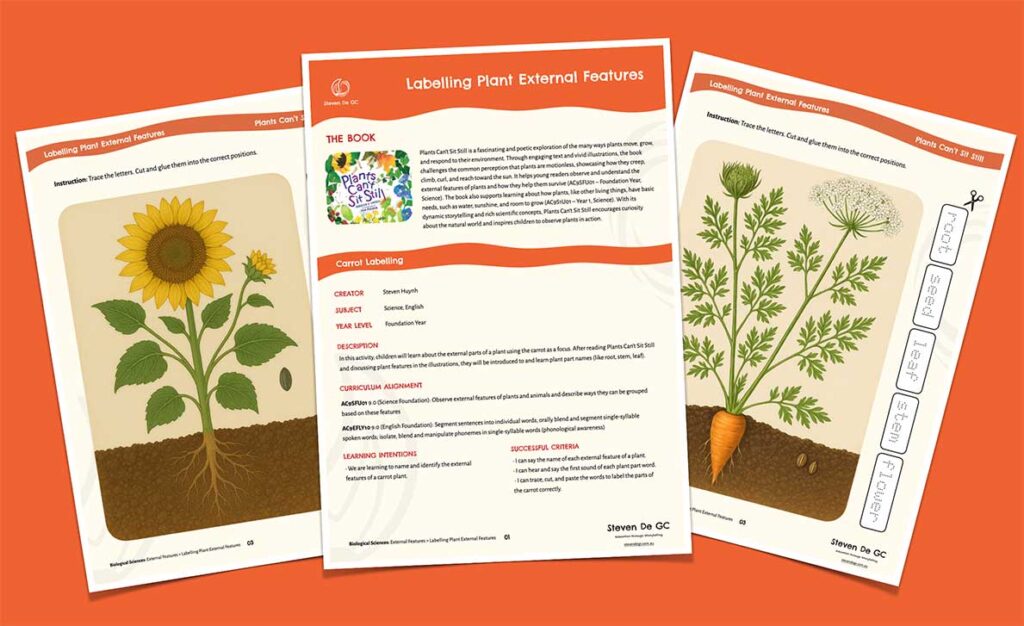- Work on each aspect of the unknown words with students:
- Pronunciation
- Definition
- Example or non-example
- Sentence formation
- Application
[T4R] Stay For Dinner: L5 Vocabulary

The Book
Stay For Dinner
Written by Sandhya Parappukkaran, illustrated by Michelle Pereira, published by Bright Light
Stay for Dinner by Sandhya Parappukkaran is a vibrant celebration of cultural diversity and the connections made through shared meals. The story centres on a family preparing a special dinner for their child’s friends, offering a glimpse into various mealtime customs and table manners (AC9HP2P01 – Years 1 and 2, Health and Physical Education). Through the lens of this dinner, the book explores the emotional responses and questions that arise from cultural traditions (AC9HP2P03 – Years 1 and 2, Health and Physical Education), encouraging children to embrace diversity and appreciate the richness of different cultural backgrounds (AC9HP2P02 – Years 1 and 2, Health and Physical Education).
The narrative is brought to life with vivid sound and imagery words such as “squish,” “splash,” “slice,” and “prong,” capturing the sensory experience of the meal. Culinary terms like “papadum,” “sadhya,” and “dumpling” add authenticity and depth, inviting readers into the world of diverse cuisines. As the main character reflects on her and her friends’ mealtime experiences, the story underscores the importance of understanding and respecting different customs, fostering a sense of togetherness and mutual respect.
With its rich illustrations and heartwarming themes, Stay for Dinner inspires children to find joy in sharing meals and traditions, highlighting the value of friendship and cultural appreciation.
Resource creator
Steven Huynh
Subject
Level
Description
This is Lesson 5 of the Talk For Reading (T4R) unit Stay For Dinner.
This lesson helps students strengthen their vocabulary so that they can better understand the meaning of the words and text.
Learning Intentions
• We are learning the meaning of unknown words in context.
Successful Criteria
• I can predict and build literal meaning of unknown words (AC9E2LY05).
• I can I can sort the examples from the non-examples with reasoning (AC9E2LY05).
• I can experiment and use the new vocabulary in a sentence (AC9E2LA09).
Curriculum Alignment
AC9E2LA09 9.0 (English Language and Literacy Year 2): Experiment with and begin to make conscious choices of vocabulary to suit the topic
• selecting vocabulary appropriate to the topic to replace everyday language
• discussing new vocabulary encountered in learning area texts
• exploring language used to describe characters in narratives, including nouns; for example, “magician”, “wizard”, “sorcerer”, and adjectives such as “gentle”, “timid” or “frightened”
• identifying words from First Nations Australians’ languages relevant to a topic
AC9E2LY05 9.0 (English Language and Literacy Year 2): Use comprehension strategies such as visualising, predicting, connecting, summarising, monitoring and questioning to build literal and inferred meaning
• listening for specific information and providing key facts or points from an informative or persuasive text
• listening and responding to detailed instructions
• integrating information from print, images and prior knowledge to make supportable inferences
• identifying the main idea of a text
• predicting vocabulary that is likely to be in a text, based on the topic and the purpose of the text; for example, predicting that “station” and “arrive” would be in a text recounting a train journey
• using prior knowledge to make and confirm predictions when reading a text
• using graphic organisers to represent the connections between characters, order of events or sequence of information
Materials
- The book Stay For Dinner
- Lesson 5: Vocabulary Slides
Instructions
Downloads
| Free Version | Paid Version | |
|---|---|---|
| Material contents | Limited | Full access |
| Instructions | Not included | Included |
| Redownloads | 5 per download | Unlimited |
| Download | FREE DOWNLOAD | BUY WITH |




![[T4R] Stay For Dinner Reading Unit for Year 2 [T4R] Stay For Dinner Reading Unit for Year 2](https://stevendegc.com.au/wp-content/uploads/2025/02/T4R-Stay-For-Dinner-UnitOverviewCover-1024x627.jpg)
![[T4R] Let’s Build a Boat: L11 Evaluation and Reflection [T4R] Let’s Build a Boat: L11 Evaluation and Reflection](https://stevendegc.com.au/wp-content/uploads/2025/05/LetsBuildaBoat-T4R-Lesson11-Cover-1024x626.jpg)
![[T4R] Let’s Build a Boat: L10 Summarising [T4R] Let’s Build a Boat: L10 Summarising](https://stevendegc.com.au/wp-content/uploads/2025/05/LetsBuildaBoat-T4R-Lesson10-Cover-1024x626.jpg)
![[T4R] Let’s Build a Boat: L9 Making Inferences [T4R] Let’s Build a Boat: L9 Making Inferences](https://stevendegc.com.au/wp-content/uploads/2025/05/LetsBuildaBoat-T4R-Lesson9-Cover-1024x625.jpg)
![[T4R] Let’s Build a Boat: L6 Writing a Boat-making Procedure [T4R] Let’s Build a Boat: L6 Writing a Boat-making Procedure](https://stevendegc.com.au/wp-content/uploads/2025/05/LetsBuildaBoat-T4R-Lesson6-Cover-1024x626.jpg)
![[T4R] Let’s Build a Boat: L5 Connecting to a Different Text [T4R] Let’s Build a Boat: L5 Connecting to a Different Text](https://stevendegc.com.au/wp-content/uploads/2025/05/LetsBuildaBoat-T4R-Lesson5-Cover-1024x626.jpg)
![[T4R] Let’s Build a Boat: L4 Literal Retrieval [T4R] Let’s Build a Boat: L4 Literal Retrieval](https://stevendegc.com.au/wp-content/uploads/2025/05/LetsBuildaBoat-T4R-Lesson4-Cover-1024x626.jpg)
![[T4R] Let’s Build a Boat: L3 Making Connections [T4R] Let’s Build a Boat: L3 Making Connections](https://stevendegc.com.au/wp-content/uploads/2025/05/LetsBuildaBoat-T4R-Lesson3-Cover-1024x625.jpg)
![[T4R] Let’s Build a Boat: L2 Making Predictions [T4R] Let’s Build a Boat: L2 Making Predictions](https://stevendegc.com.au/wp-content/uploads/2025/05/LetsBuildaBoat-T4R-L2-Cover-1024x627.jpg)
![[T4R] Let’s Build a Boat: L1 Background Knowledge [T4R] Let’s Build a Boat: L1 Background Knowledge](https://stevendegc.com.au/wp-content/uploads/2025/05/LetsBuildaBoat-T4R-L1-Cover-1024x626.jpg)

Leave a Reply